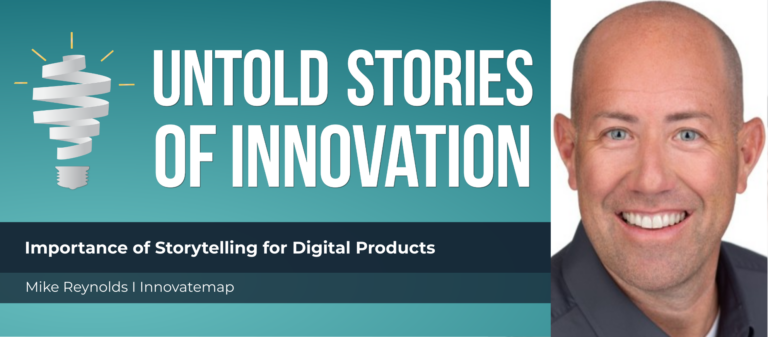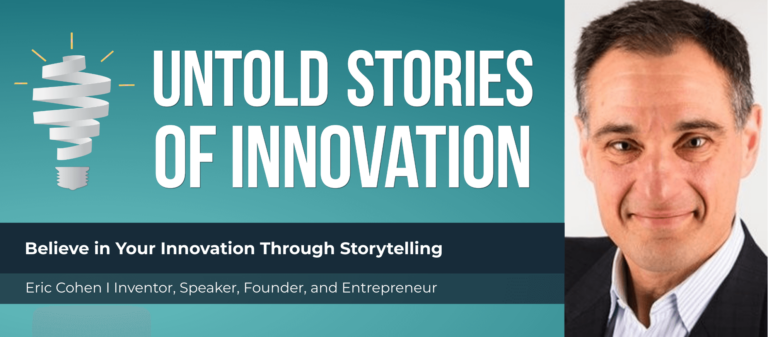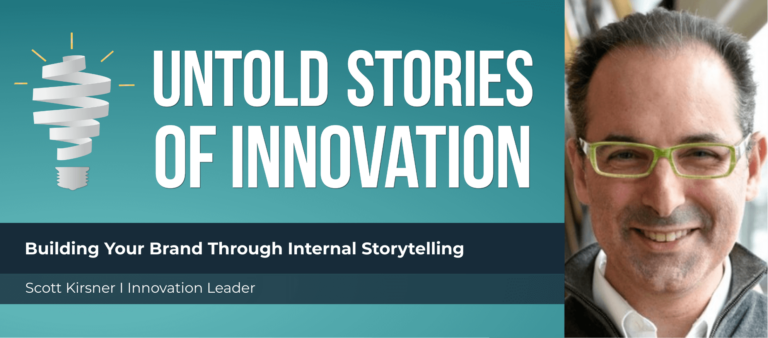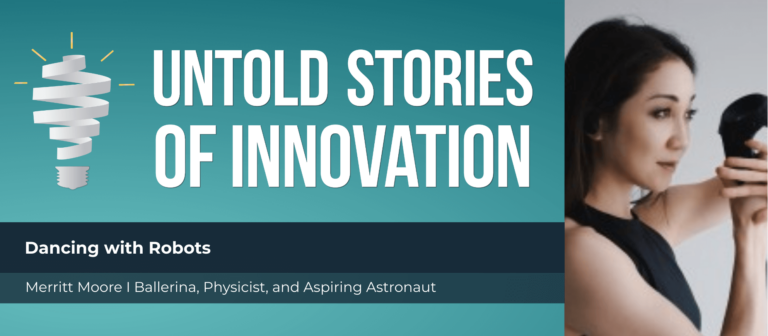Passion Points of Innovation with Melissa Pickering of LEGO
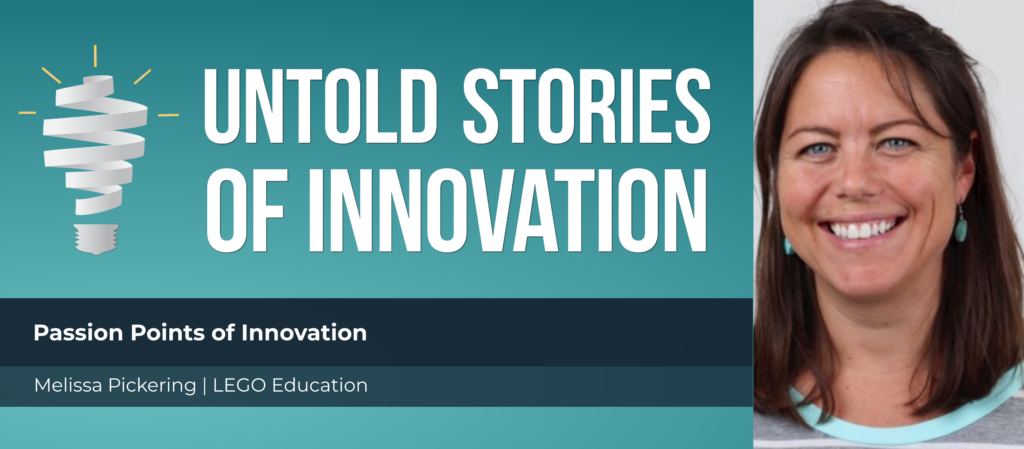
Untold Stories of Innovation
“It is about stirring emotions in your listeners and storytelling is absolutely a powerful way to do that.” - Melissa Pickering, Director at LEGO Education
From today’s episode you’ll learn:
Why do stories matter to the innovation process? What values can be instilled in innovators who share stories? How do innovation leaders inspire creators to tell and share their success and failure stories?
It isn’t the latest and greatest technological innovation that is guaranteed to inspire passion. Innovators need to be interested in their prospective audience’s interests to craft a compelling innovation story. Melissa Pickering, Director at LEGO Education, tells us how innovators can create a captivating, successful innovation by having an innovation story that speaks to the consumer’s passion points. Passion-driven storytelling also comes into play in the early stages of the innovation process as a mechanism to garner buy-in and support from internal teams. Learn more about how LEGO utilizes test failures, storytelling, and passion points to curate their products! Also, make sure to check out Melissa’s inspiring Ted Talk regarding how tech should be designed for kids.

Melissa Pickering is Director at LEGO Education. Melissa is passionate about building and leading cross-functional teams to develop and launch products for kids. As an innovative entrepreneur, Melissa identified a market need for research-based kids' products, then built & sold an educational software startup. Make sure to check out Melissa’s TED Talk, “How Tech Should Be Designed for Kids,” and learn how innovators need to keep consumers and their passion points in mind for a truly appealing innovation story.
TRANSCRIPT
This episode is powered by Untold Content’s Innovation Storytelling Training. Increase buy in for your best ideas in this immersive and interactive, story-driven experience. Where your teams refine storytelling techniques for their latest projects, prototypes and pitches—and get inspired by 25 epic examples of impactful innovation stories.
Katie Trauth Taylor: [00:00:04] Welcome to Untold Stories of Innovation, where we amplify untold stories of insight, impact and innovation. Powered by Untold Content. I’m your host, Katie Trauth Taylor.
Katie Trauth Taylor: [00:00:19] Our guest today is Melissa Pickering. She’s the head of interactive play at the LEGO Group. She’s an entrepreneurial leader, a product innovation specialist, and a digital transformation expert. She also recently gave a TED talk on how tech should be designed for kids. Melissa, thank you so much for being on the podcast.
Melissa Pickering: [00:00:38] Thank you for having me.
Katie Trauth Taylor: [00:00:39] Interactive play. That sounds like a really fun job.
Melissa Pickering: [00:00:43] Passion points of innovation – Yes, it absolutely is. And it basically is our term for, you know, kids are playing differently and they have been for a while in terms of the introduction of screens. And so we firmly believe, though, that play in the physical world is still so important. So our primary task is to look at how we leverage digital technology to further enhance the physical play for kids around the world.
Katie Trauth Taylor: [00:01:09] Amazing. So your work in particular, it sounds like it’s quite a bit about digital and tech and the ways in which children will play back – And I guess in adults, too, right? Adults still play with Legos – but the way that we sort of play back and forth then between different modalities.
Melissa Pickering: [00:01:28] Passion points of innovation – Yes, that’s absolutely true. And sometimes we call it one reality or fluid play. Just just noting that no matter the motor medium, there’s so many different ways to have a playful experience. And, you know, whether it’s using robotics and coding or augmented reality or other types of technologies… Our first and foremost starting point is: what is a fun, playful experience? And then from there we move to: then how how do we do that?
Katie Trauth Taylor: [00:02:02] Passion points of innovation – I love that point. And one of my favorite aspects of your TED talk is that you really take us back to basics and explain what play is and why children can engage, even in nature to… Why nature is such a wonderful inspiration for play. Tell us a little bit more about how tech should be designed for kids.
Melissa Pickering: [00:02:22] Passion points of innovation – Yes. So, you know, there’s – we – there are a couple of different types of play. And particularly what I reference in my talk is this notion of free play or or open-ended play. And in that space, that’s really where we see imagination and creativity that kids have really coming to life. And in the three key principles for free play is, one, around intrinsic motivation. So experiences that naturally you are motivated to do and not… the opposite of that would be an extrinsic motivator. So these are things with… Where, you know, games with rules and points and in some of these achievements that you’re trying to make, that would be the opposite of intrinsic motivation. So one is intrinsic motivation. Two is active engagement. So this is where, you know, you’re actively creating, doing, being in a play experience and the opposite of that would be passive. So this is where, you know, watching something on a screen for an extended period of time and we get sort of in that passive mode. And then three, of course, it should go without saying that we really believe in those joyful moments. So in our design process and the team, we talk a lot about what are those magic moments that really invoke joy? And if you think about sometimes magic moments can come from a struggle as well. So that feeling of being proud, once you’ve achieved something, like practicing jump rope and you finally get what it is that you want. So. So those joyful magic moments, they don’t necessarily have to be, you know, about surprise and wonder all the time, but also can come from maybe a hard struggle that you’ve been working on for some time.
Katie Trauth Taylor: [00:04:14] Passion points of innovation – Yeah. As I’m listening to you describe these different layers of play or levels of play. I keep thinking not just about children at play, but about how those lessons are so applicable to our professional lives, too. That if we can approach our work with the idea that we are at play, that that could be transformative in some ways. Have you given much thought or do you talk about that at a cultural level inside Lego?
Melissa Pickering: [00:04:43] Passion points of innovation – We do. And I think it’s, you know, it sort of goes without saying in our work because we are in and around the Lego-brick medium on a daily basis. And having, you know, brainstorm sessions and design, you know, drawing out user journeys and using all kinds of different things to lean in. And it’s a very collaborative culture, I find, particularly at Lego. And so all of our design processes are extremely collaborative in and of themselves. And so with that saying then inherently, it is very active, right? When you’re sort of leaning in and participating in different design and brainstorming sessions, you are actively engaged. So it’s – I would say because it is what we’re doing, we are toy designers, it does come a bit natural with the territory.
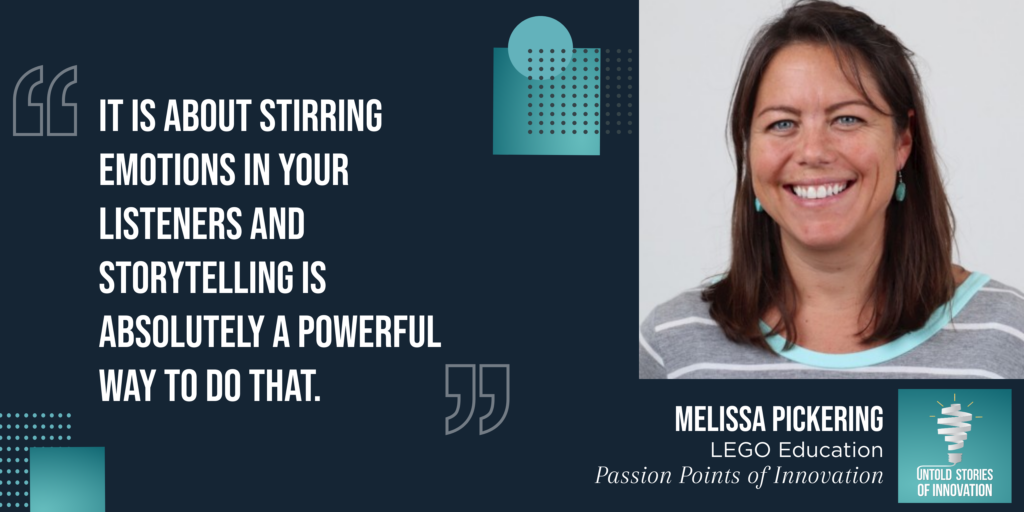
Katie Trauth Taylor: [00:05:40] Passion points of innovation – Absolutely. Can you take us inside? I know you might not be able to share a lot of insight into internal sessions like that. But do you have any stories that you could share that would sort of bring to life some of the current projects or even just the mindset that you tend to see among your teams?
Melissa Pickering: [00:06:00] Passion points of innovation – Yes. Yeah, I think one of the things that I like to enforce on our team is never really taking ourselves too seriously. And and it’s it’s funny how sometimes, you know, a conversation or meeting about a certain color of a brick on a model can get into something very intense, right? Or the name of a monster of a new story that we’re creating. And sometimes it’s really important to take a step back and have a laugh and think about, you know, we are designing toys and new experiences and stories for kids. So. So don’t get too angry about whether that should be a light green or dark green, right? So I think that’s one key principle that I, particularly as a leader in our team, like to reinforce. And that just naturally creates a little bit of a lighthearted atmosphere and one of the funny things we have, I don’t know if you’re familiar, we had a product released about three years ago that was a robotics product. So it’s called BOOST. And one of the… You could build one of five different models and one of the models was a cat. And the cat’s name is Frankie. And in the experience, you can feed Frankie and you can build a little milk bottle and then hold it up to Frankie’s mouth, which has a sensor in it. And then Frankie the Cat will meow and purr. And so there was a…
Katie Trauth Taylor: [00:07:34] Yes.
Melissa Pickering: [00:07:34] Passion points of innovation – There was a prototype being worked on for that. And in this big open space, I think, for an entire week, when the designers and [unclear wording] were continuing to work on and work out the kinks. All you could just hear was just a repetition of a cat meowing and purring in this big atrium. And, you know, it’s just little things like that where it does make you take things a little bit less seriously.
Katie Trauth Taylor: [00:08:03] Passion points of innovation – You know, projects like BOOST… Thank you so much for sharing that example. I love that image. And products like BOOST are so interesting because they really encapsulate that fluid play that you were describing, that fluid motion between the digital world and the physical world. And our children, I think, are sort of uniquely positioned to… Well, we’re positioned, I think, as innovation leaders to help them navigate those distinctions between what is reality and what is not. So can you share with us some more? You know, I love your, again in your TED talk you talk about some of those distinctions and how we need to be responsible in our ways of designing environments of play for children, especially as coders and engineers. Tell us a little bit more about what you’ve learned at Lego and why it matters to take an ethical, and where possible, a participatory approach to design for games for kids.
Melissa Pickering: [00:08:59] Passion points of innovation – Yes, I think, you know, kids are… They are still developing and developing that sense of control and understanding, you know, what is right and wrong. And so the more that we can lean in to provide a space to nurture the creativity that they already have and fuel the imagination that they already have. I think we, you know, I personally believe we will then naturally have strong, you know, 21st-century citizens in the future. And, you know, particularly in our design process, we do a number of… we create prototypes. We test with kids, we test with kids all the time and work with them and get feedback. And there are times when, you know, there’s been a couple examples in the past where we want to provide an engaging experience, right? And, you know, we’ve had implementations of an experience and we put in front of kids. And then what’s happened, you know, maybe we used a little mechanic, like giving little rewards as they continue to build something or go through the experience. And then what we found is just watching the kids. Then they become… All of a sudden their mind is transferred from the physical world and the building and play experience and more about then how to get more points on the screen. And that’s where we’ve had the halt in our design process and [we] take a step back and say, “OK, is this the behavior that we want to create? And like, are there other mechanisms that we can use to inspire and motivate that build and play loop without using some of these game mechanics that if overused and can take the kids in a different direction?”
Katie Trauth Taylor: [00:10:45] Passion points of innovation – Yes, it’s such an interesting balance between the mechanics and then the way children will use it and also sort of how the imagination plays a space and whether those mechanics allow space for imagination. But so many different factors to be thinking about. Can you tell us a little bit more about other innovation stories coming out of your team?
Melissa Pickering: [00:11:09] Passion points of innovation – Yes. So we have one that was just launched – or not launched – it’s going to be launched later this year. But it was actually just announced last week. And we’ve teamed up with – Lego has teamed up with Nintendo – and it’s a Lego Super Mario. And that, as you can see online, there is an interactive Mario that kids can play with and build out different Lego levels for it for them to play their Mario in. And that has been a really interesting journey for the team because, you know, it is about a game. You know, it’s teaming up with a game company. It is about creating this game and using these icons. But in a… In a space that gives kids the opportunity to be imaginative and creating their own… Building their own game levels out of Lego bricks. So that’s one specific one that’s hot off the press as of last week that we’ll be launching later this year.
Katie Trauth Taylor: [00:12:10] Passion points of innovation – That’s incredible. And what about the digital aspects? Is that – is that a particularly tech-enabled product?
Melissa Pickering: [00:12:17] Yes. Yep. So. So those… Mario has technology in it which allows it to react in… From the different bricks. So if you hold it over a red brick then he’s sort of experiencing fire on his feet and these sorts of reactions.
Katie Trauth Taylor: [00:12:36] Innovation storytelling – That’s incredible. So what are some of the technologies that you at Lego are already strongly implementing and what do you think is on the horizon?
Melissa Pickering: [00:12:45] Innovation storytelling – That’s a good question, because we often don’t, you know, we’re not innovating from a technology perspective. And that’s where our, you know, our briefs that we work on. We don’t take a starting point of looking at technology. We challenge ourselves instead to look at new play experiences and what is relevant for kids’ play. You know, also mapping to the world around them. So thinking about these trends around, you know, being more mindful about time nor what with sustainability. Right. And, you know, when we think about what the new cities that kids will be and how do we… How do we create play experiences that’s evolving and relating to them as they are growing up in the world? And so that’s… We look at these macro-trends and then create play experience briefs from that. And then we use existing technology or maybe some technology-components in order to deliver to that play experience. So that’s how we turn that on its head. So we’re not necessarily looking at, you know, the next new innovative technology, but really, what is the play that’s relevant for kids moving forward?
Katie Trauth Taylor: [00:14:03] Innovation storytelling – I love that. And I, you know, I think a lot of conferences, I’ve heard that same wisdom. That we need to put the – our people – in front of the technology itself. Can you share… I heard you mention your technical briefs or creative briefs. And also just analyzing macro-trends. Can you share with us the way that storytelling plays a role in those aspects of your innovation process?
Melissa Pickering: [00:14:32] Innovation storytelling – Yes, absolutely. So I would say storytelling is used quite often when we look at user journey. So what are key personas and experiences? And of course, we have [unclear wording] the kids, but then we talk about what are their passion points and tell a little story about these kids. Also, you know, the world, that they live in and what is the family that they live in? And so that is a story in itself in helping us really think about the user now and in the future. And then we use storytelling, [unclear wording], in our area. There is a challenge in communicating these new digital physical play experiences internally because it is tough to kind of imagine and see. And we’re so used to looking… Being able to look at a physical model and really right away seeing and understanding the play. Like when you see a Disney Castle, you can kind of understand and see the play there. But when you talk about this, you know, this robotic cat that you can code in order to make it come alive. That’s a little bit intangible. So we have to rely heavily on storyboards, metaphors, these things just for internal selling-in, as well as bringing people onboard in the journey of pushing the innovation of these new digital physical experiences. So I think we use it in two different ways.
Katie Trauth Taylor: [00:16:00] Innovation storytelling – Yes. So it’s a way of really deeply understanding the players and also generating buy-in internally. Let’s start – I love that you used, when it comes to painting really clear and accurate images of your… of children at play – I love that you use the term “passion points.” I think people talk a lot about “pain points” of their consumers, but not necessarily their “passion points.” Can you tell us more about that?
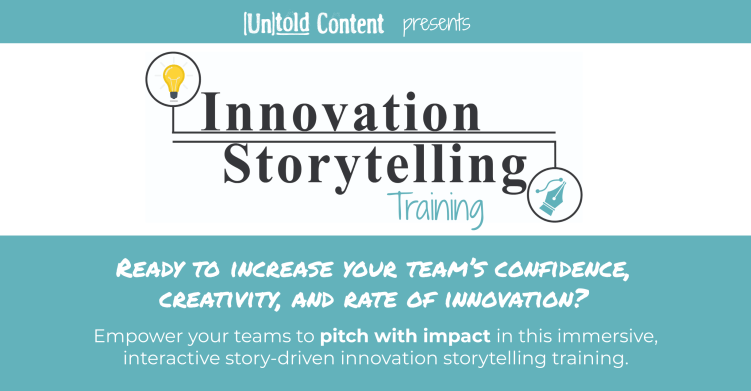
Melissa Pickering: [00:16:27] Innovation storytelling – Yes. So, you know, this can be something as simple as a “passion points” of horses or Star Wars or some of these… Unicorns are a very popular one at the moment. So that’s what we think of. And it’s really just the interests and the particular… We also talk about “play types.” So. So it’s just certain ways that certain kids and their personalities tend to like to play. So whether it’s a first-person role play or third-person role play. So we blend those and “passion points,” just their interest. And their passion points change as they say, not only grow up, but then also in… As these trends happen, too. So maybe, you know, a strong passion point for a lot of kids is around sports, right? And that is also something we have to take into our consideration in our design process.
Katie Trauth Taylor: [00:17:32] Innovation storytelling – I love that. Yes, I was laughing to myself, thinking about my five year old right now, somehow found mermaid unicorns. Both trends are so strong right now that now they’re making this hybrid model. So…
Melissa Pickering: [00:17:47] Oh my gosh.
Katie Trauth Taylor: [00:17:49] Innovation storytelling – Yes. And I’m sure like three months from now it’ll be something different. But that’s what we’re into right now. Let’s talk a little bit more about buy-in internally, too, because this is a – this is a topic that’s come up a lot in my interviews with thought leaders like yourself. So when you’re generating internal buy-in, what does that look like at the moment where the seed of an idea is just starting? And then how does that change as a project actually gets approved and is underway?
Melissa Pickering: [00:18:17] Innovation storytelling – We, you know, we have a – we work with a pretty standard innovation gate process. But it’s…. Usually, in terms of that seed transforming into an approved project, it has, I would say, three key elements. And one is where people can… Everyone in the organization, they can really feel and experience the new play. And so that’s where we have to use storytelling to somehow evoke some sort of emotion. And, you know, we oftentimes have to make what we call fake-o- types. So prototypes that aren’t necessarily actual working.But just to get people’s hands and experience them. So they have an emotional – and people meaning leadership – and so they have an emotional attachment to that. You know, feedback from kids, we do so much kids testing. And so that’s a key point of really sharing our journey of where we’ve been. You know, there’s not… Not all kids test experiences are very good. You know, it’s also, we found it’s helpful to share the kids test where the experience actually completely flopped because then that also provides more credibility to the selling and process when you sort of share those stumbles as well through the design journey.
Katie Trauth Taylor: [00:19:50] Innovation storytelling – Tell me more about that. So is that a way of showing that you were responsive to feedback and you were avoiding sort of “epic failure” by being willing to pivot and change?
Melissa Pickering: [00:20:00] Innovation storytelling – Yes, that and also, you know, it’s… When people just keep talking about, “oh, and the kids love this and they thought it was the best play experience and they made all these things where it can….” We – Everyone hears that a lot. And so it’s also kind of a direct rally when you hear actually we tried this new model and the kit, you know, all of the kids of this age group hated it and they are bored and they were, you know, wanted to go play Fortnite. And so that also helps people, I think, remember, as well as make everything else that we’re sharing more credible. In addition to what you’re saying of then OK, now, then we took in that feedback and then we adjusted. But the whole story becomes a lot more credible.
Katie Trauth Taylor: [00:20:56] Innovation storytelling – I love the two. I feel like the two key points that you made there that I want to lean into most are, one, the surprise element of adding something like that into your innovation story. Adding the failure, I guess I should say, into your innovation story creates an element of surprise that will make it more memorable to the listener. So that’s one point. And then the second point is really the humility to say that and to sort of rattle how things are typically done. We work with a lot of scientists and engineers at Untold. And it’s interesting… If we’re supporting them, for instance, in designing a deck or a scientific poster for a conference, we’ll make sure that we really clearly understand the audience that they’re… That they want this design to be for. Because we’ll oftentimes hear that if it’s too beautiful, if it’s too professionally designed, the scientific community will be much more skeptical of the validity of the findings.
Melissa Pickering: [00:21:57] Wow. That’s so interesting.
Katie Trauth Taylor: [00:21:59] Innovation storytelling – Yes. So it just reminds me of what you’re… You know, what you’re talking about, which is the fallacy of kind of overemphasizing the impact or the market potential or how positive it’s going to be. You’re sort of going to generate skepticism if you’re overly optimistic because people like to be I think, you know, make sure that we’re all kind of being reasonable and using logic. But, yeah, in the scientific community, if something is overdesigned, it can be seen as less credible.
Melissa Pickering: [00:22:28] Innovation storytelling – Huh. That’s interesting. I wouldn’t have expected that.
Katie Trauth Taylor: [00:22:32] So who needs to buy into these innovation stories?
Melissa Pickering: [00:22:36] So the leadership teams need to buy in and in order for, I guess, the seed of an idea to then become a project that is resourced and supported. And the leadership, you know, is from all different backgrounds and cultures as well as experience in Legos. So there is a range of stakeholders. It’s like basically, you know, getting investment except it’s one investment board instead of a number of different investors, venture firms out there. So…
Katie Trauth Taylor: [00:23:19] Innovation storytelling – Right, yeah, absolutely. And so how do you ensure that, you know, that the innovations that you’re sharing and the stories that you’re sharing with those stakeholders, that they are aligned with their needs and their mission and their values?
Melissa Pickering: [00:23:34] I think it’s definitely a learning process. I think one of the things that I share with my team is, is making sure, you know, a lot of times you go into presentations and you just want to use the entire 30 minutes or 45 minutes or whatever it may be, just to get as much information out there and to give your whole pitch and squeeze it in. And what I’ve encouraged a team to do is, you know, make sure you’re not taking up the entire time, like leave at least 10 minutes or something, just to understand the questions and the types of questions that are asked, because that’s the biggest opportunity to get a little bit more insight into what each person’s agenda has to then do a loop again. And so you’re… You can continue sharpening the presentation because the worst, and I’ve seen this happen many times and I’ve actually experienced myself, is when you just use all of your breath to say what you want to say. And then, you know, you get feedback later that maybe the idea is not going forward and you don’t really have an opportunity to understand why. And when you have that panel of the leaders in the room that normally have extremely packed schedules, then absolutely take the opportunity to understand the questions and what’s on their top of mind.
Katie Trauth Taylor: [00:24:55] Yes, that’s such good advice, I think, especially as ideas get shelved and communications lacking. And I think there’s a lesson there, too, for those listening to this podcast who are in leadership roles and you are the ones approving innovation projects to make sure that that feedback is very clear to the innovators and the people on your team who are working so hard to come up with ideas. Because one of the most challenging aspects of being innovative is just the resiliency that it takes to accept when something doesn’t get green-lighted and understand when it gets shelved or killed. And so, yeah, I just think that there’s probably advice on both sides of that equation there.
Melissa Pickering: [00:25:35] Yeah, absolutely. That’s a really good point.
Katie Trauth Taylor: [00:25:38] So what other advice would you give to innovators as they prepare to convey their great ideas?
Melissa Pickering: [00:25:50] Passion points of innovation – I think. Yeah, I mean, I guess it’s… kind of goes along with your focus and the focus of this podcast, is not underestimating the power of storytelling. And that is, you know, I think about how I watch many, many, many presentations, too. And the ones that you can really remember are where, you know, you are forced to be transported into a world or relate to a you know, your walk through and experience from the point of view of an eight year old girl. And you just have these little details in the presentation and just help paint a common picture in people’s heads. And I, I just firmly believe that that’s a very powerful way. Maybe it can feel manipulative sometimes, but at the end of the day it is about stirring emotions in your listeners and storytelling is absolutely a powerful way to do that.
Katie Trauth Taylor: [00:26:54] Passion points of innovation – And I think, too, it’s definitely authentic when it’s coming from a place where there’s so much truth to that. I look at my children playing with Legos, and I think if you as an innovator are able to share an insight into what that play looks like and who that person is, I know that from a consumer’s perspective that’s so valuable and not at all something that should be viewed as, you know, storytelling in the sense of lying, right? It’s really about bringing someone’s experience to life and making sure that that aligns really clearly with what the vision is for that innovation. So I love that advice. Thank you so much for sharing that. And thank you for being on the podcast. I am so humbled to have you on. And I can’t wait to hear more of your thoughts as you continue to put out amazing work at Lego.
Melissa Pickering: [00:27:46] Passion points of innovation – Thank you. Thanks for having me on. And I love the mission that you guys have. I think it’s very important. So thank you.
Katie Trauth Taylor: [00:27:53] Thanks, Melissa.
Katie Trauth Taylor: [00:27:56] Passion points of innovation – Thanks for listening to this week’s episode. Be sure to follow us on social media and add your voice to the conversation. You can find us at Untold Content.
You can listen to more episodes of Untold Stories of Innovation Podcast.
*Interviews are not endorsements of individuals or businesses.Innovation Storytelling

